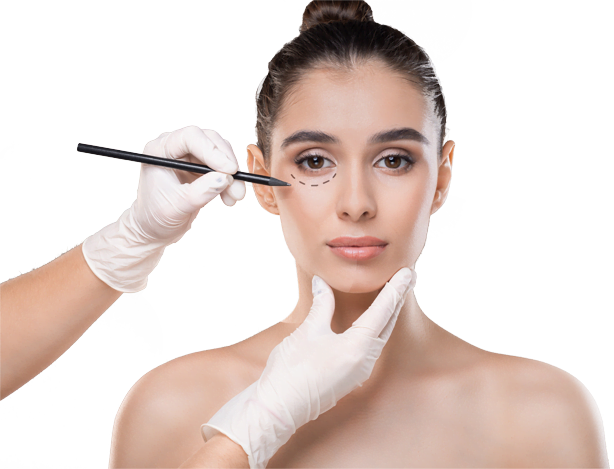Table of Contents
Crafting a Delicate and Harmonious Nose
One of the most impactful procedures in Facial Feminization Surgery (FFS) is rhinoplasty. This procedure reshapes the nose to achieve a more delicate and feminine appearance, contributing significantly to overall facial balance and harmony. For transgender women, rhinoplasty offers a powerful tool to express their authentic selves and embrace a facial aesthetic that aligns with their gender identity.
The Significance of the Nose:
The nose plays a central role in facial aesthetics. Its size, shape, and projection significantly impact facial balance and femininity. A prominent or masculine nose can detract from overall facial harmony, while a delicate and refined nose can enhance femininity and create a more youthful appearance.
Rhinoplasty for Feminization:
A skilled FFS surgeon can utilize specific rhinoplasty techniques to achieve the desired feminine features. These techniques may include:
- Reducing the bridge height: This creates a smoother and more delicate appearance.
- Refining the tip: A smaller and more rounded tip contributes to a feminine aesthetic.
- Narrowing the nostrils: This creates a more delicate and proportionate appearance.
- Adjusting the angle: Tilting the tip slightly upwards enhances femininity and creates a more youthful look.
- Correcting any existing nasal deformities: These may include humps, bumps, or other irregularities.
Benefits of Rhinoplasty for FFS:
- Enhanced facial femininity: Creates a more delicate and harmonious facial appearance.
- Increased self-confidence: Feeling good about your appearance can boost confidence and self-esteem.
- Improved facial balance: Creates a more proportionate and aesthetically pleasing appearance.
- Addressing functional concerns: Corrects any existing breathing difficulties related to the nose.
- Long-lasting results: Rhinoplasty results can last for many years or even a lifetime.
Exploring Techniques and Considerations
Having established the significance of rhinoplasty in Facial Feminization Surgery (FFS) in Part 1, let’s delve deeper into the various techniques employed by skilled FFS surgeons to achieve a delicate and feminine nose:
Open vs. Closed Rhinoplasty:
- Open Rhinoplasty: This technique involves a small incision across the columella (the tissue separating the nostrils) and provides the surgeon with greater access and visibility to the nasal structures. This allows for more precise adjustments and complex modifications.
- Closed Rhinoplasty: This technique utilizes incisions inside the nostrils, leaving no visible scar on the columella. It is suitable for less complex procedures and offers quicker healing times.
Surgical Approaches:
- Bone Reshaping: Techniques like osteotomies involve strategically weakening and repositioning the nasal bones to achieve the desired bridge height and profile.
- Cartilage Reshaping: Techniques like suturing and trimming refine the cartilage structures of the nose, creating a smaller and more delicate tip and narrowing the nostrils.
- Grafting: In some cases, cartilage grafts may be used to augment certain areas of the nose and achieve the desired shape and projection.
Considerations for a Successful Outcome:
- Individualized approach: Every individual’s facial anatomy and desired outcome are unique. Surgeons tailor their approach to address specific needs and achieve personalized results that harmonize with the individual’s overall facial features.
- Surgeon’s experience and skill: Choose a qualified FFS surgeon with extensive experience in rhinoplasty and a proven track record of successful outcomes in feminization surgery.
- Pre-operative consultation: This is a crucial step to discuss your goals, expectations, and any concerns you may have. The surgeon will assess your facial structure and determine the most appropriate approach for your individual needs.
- Realistic expectations: Remember that achieving a natural-looking and feminine nose takes time and proper healing. Set realistic expectations for the outcome and communicate openly with your surgeon throughout the process.
Navigating Recovery for a Successful Outcome
Following your rhinoplasty procedure, navigating the recovery process is crucial for ensuring optimal healing and achieving the desired outcome. Here’s what to expect and how to optimize your recovery journey:
Immediate Post-Operative Care:
- Swelling and Bruising: Expect some swelling and bruising around the nose and eyes that may peak within 2-3 days and gradually subside over the following weeks.
- Splint and Nasal Packing: A splint will be placed on your nose to stabilize the newly reshaped structures, while nasal packing may be used to control bleeding and support the healing process. These will be removed after a few days.
- Pain Management: Your surgeon will prescribe medication to manage any discomfort or pain. Follow instructions carefully and take medication as directed.
- Head Elevation: Elevate your head while sleeping and resting to reduce swelling and promote drainage.
- Ice Packs: Apply ice packs wrapped in a cloth to the affected area for short intervals to minimize swelling and discomfort.
- Wound Care: Keep your incisions clean and dry. Follow the surgeon’s instructions for cleaning and applying any prescribed ointments.
Recovery Timeline:
- Week 1: Most swelling and bruising will subside, and the splint and packing will be removed. You may still experience some discomfort and tenderness.
- Weeks 2-4: The nose will continue to heal and refine its shape. You can gradually resume normal activities but avoid strenuous exercise or contact sports.
- Months 3-6: Most visible swelling and bruising will resolve, and the final shape of your nose will become more apparent.
- Up to 1 Year: The nose continues to refine and settle into its final, natural-looking shape.
Tips for a Smooth Recovery:
- Get enough rest: Allow your body ample time to heal and recover.
- Maintain a healthy diet: Eat nutritious foods rich in vitamins and minerals to support healing.
- Avoid smoking and alcohol: These substances can impair healing and increase the risk of complications.
- Protect your nose from the sun: Wear sunscreen with SPF 30 or higher to protect your nose from harmful UV rays during the healing process.
- Avoid strenuous activities: Refrain from strenuous exercise or activities that could put pressure on your nose until cleared by your surgeon.
- Attend follow-up appointments: Regular follow-up appointments with your surgeon are essential to monitor your progress and address any concerns.
By following these guidelines and prioritizing your well-being, you can optimize your recovery journey and achieve a successful rhinoplasty outcome that contributes to a more delicate and feminine facial appearance.
Frequently Asked Questions (FAQ’s)
Having explored the benefits, techniques, and recovery process for rhinoplasty in Facial Feminization Surgery (FFS) throughout the previous parts, this final section addresses frequently asked questions to empower you with the information needed for informed decision-making about this transformative procedure.
Q: Am I a good candidate for rhinoplasty for FFS?
A: This procedure can be beneficial for transgender women who desire a more delicate and feminine nose that aligns with their authentic self. A qualified FFS surgeon can assess your individual anatomy and goals to determine your candidacy for this procedure.
Q: What are the risks associated with rhinoplasty for FFS?
A: As with any surgery, there are potential risks associated with rhinoplasty. These include infection, bleeding, breathing difficulties, scarring, and nerve damage. However, these risks can be minimized by choosing a qualified and experienced surgeon and following proper post-operative care instructions.
Q: How much does rhinoplasty for FFS cost?
A: The cost of rhinoplasty for FFS varies depending on the surgeon’s experience, the complexity of the procedure, and geographical location. Consult with potential surgeons to discuss fees and explore financing options.
Q: Will my insurance cover rhinoplasty for FFS?
A: Insurance coverage for FFS procedures varies depending on the provider and specific policy terms. Consult your insurance company to understand potential coverage options.
Q: What questions should I ask my FFS surgeon during the consultation?
A: Utilize this consultation to gather crucial information and ensure you feel comfortable with the chosen surgeon. Ask questions about their experience in FFS and rhinoplasty, their approach to achieving your desired outcome, potential risks and complications, and post-operative care instructions.
Q: How long will the results of rhinoplasty last?
A: The results of rhinoplasty are considered permanent. However, the nose continues to age and experience subtle changes over time.
Q: Will I have visible scarring after rhinoplasty?
A: The type of rhinoplasty technique employed determines the location and visibility of scars. Open rhinoplasty leaves a small scar across the columella, while closed rhinoplasty leaves no visible scars. These scars typically fade over time and can be minimized with proper wound care.
Q: How can I find a qualified FFS surgeon for rhinoplasty?
A: Several resources can help you find a qualified FFS surgeon, including professional organizations like the World Professional Association for Transgender Health (WPATH) and online communities dedicated to FFS.
By seeking answers to your questions and engaging in open communication with your chosen surgeon, you can approach rhinoplasty for FFS with confidence and embark on a transformative journey towards achieving your desired facial aesthetic.

